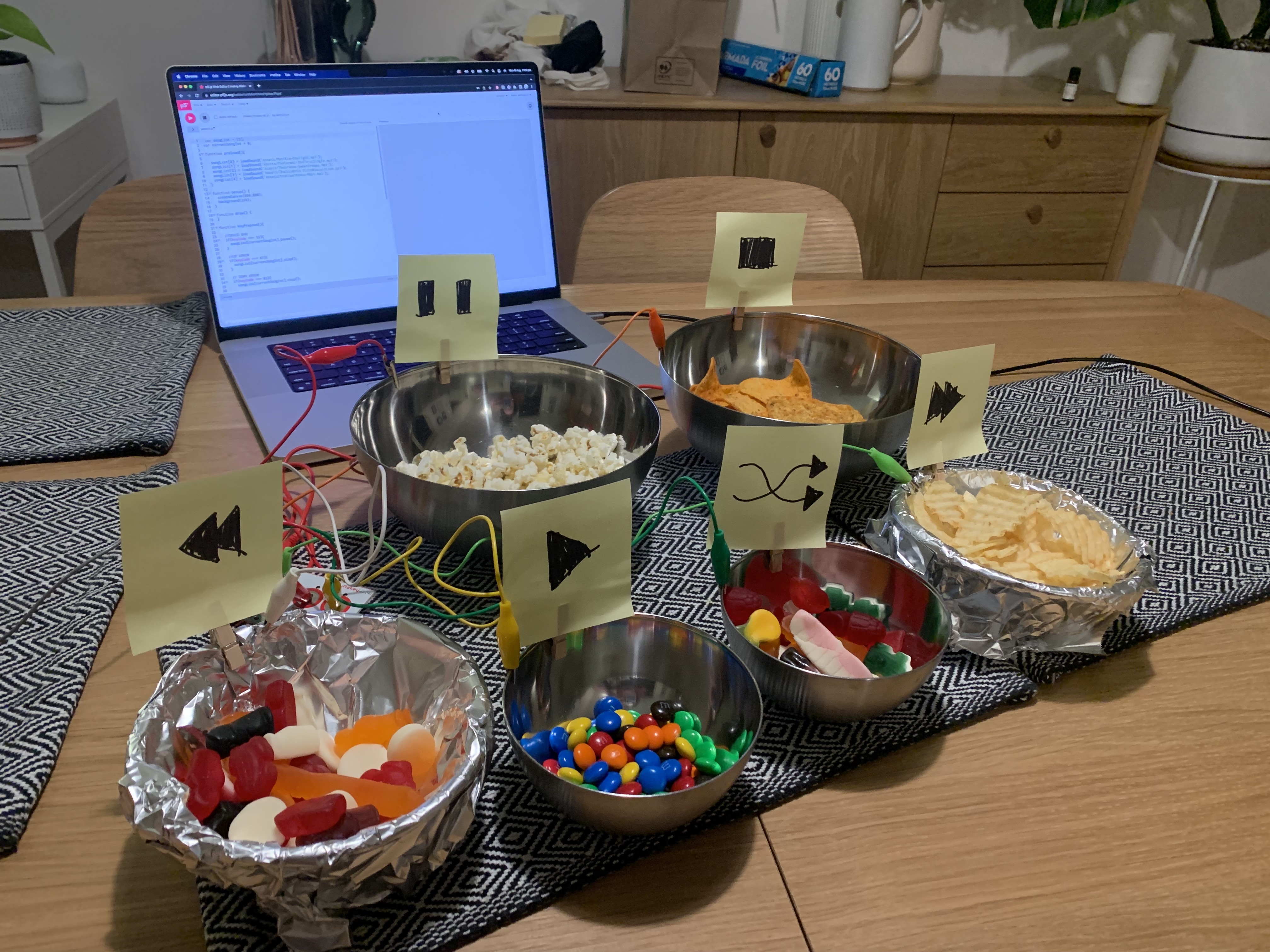
Video documentation of my response is viewable here
Theme :
I wanted to branch out from my regular digital / web based practice, and try to make a physical object that could be interacted with, because I believed it was more in tune with the theme, and would be a good exercise for me.
I took inspiration from the chindogu, or ‘un-useless’, inventions of Kenji Kawakami, which are objects that are made to serve a purpose, but are so silly and impractical that they’re almost useless. Prominent examples are the butter stick, the umbrella shoes, and the eye drop glasses.I was also inspired by the creations of Simone Giertz, who builds ‘shitty’ robots to help mundane tasks, with intentionally humorous results.
The scenario I developed is this. You’re chilling out, listening to music and eating some snacks. You want to change the song, but you don’t want to get your greasy food fingers all over your phone/computer/music system. Enter the DJ Snack Station, where the serving bowls double as the controls for the music!
Method :
My first step was to plan out the list of functions that I wanted /needed. As well as having the options to play / pause / stop the music, I decided I wanted to be able to play the next song, play the previous song, and to shuffle the playlist.
After this I spent time familiarising myself with the Makey Makey kit. I read through some of the information / tutorials on their website, and did some tests to make sure the kit I had was working as it should be.
I wrote the code in the p5.js web editor. I loaded a small amount of mp3 files into my ‘playlist’ array, and then tested out that I could play the sound files in the sketch (just using the .play() and .stop() functions on mousePressed and keyPressed respectively. Satisfied it was working, I coded each function I wanted in turn, while assigning them to a specific input event; left mouse button to play music, spacebar to pause, up arrow to stop playback, left arrow to play the previous song in the array and right to play the next song, and finally down to shuffle the playlist array.
Once this was all working it was time to test it out with the makey makey. I made placeholder buttons using squares of folded aluminium foil, each labelled so I knew what button did what. During testing I realised that the makey makeys up/down/left/right arrows were being read as the WASD keys in the p5.js sketch, so I had to quickly adjust my code to correct the error. At this point the code and the makey makey were working exactly as I wanted them to.
Once I had acquired the correct props (snacks) I recreated the Makey Makey set up using the metal / aluminium foil covered mixing bowls in place of the foil squares, with little signs indicating what each bowl did attached to them via wooden pegs.
Context :
Because my production this week was inspired by chindogu, the exercise ties into the Rhetoric of Frivolity (Sutton-Smith, 2001). Part of the joy I derived from the production of the object was due to its impractical, whimsical nature. I was making something that was designed to be silly, and that felt freeing.
My final object also has elements of performance play (Sutton-Smith, 2001) in it. While not a musical instrument, my response takes inspiration from the act of DJing, and requires the user to move their body in order to interact with the different controls, and to affect the music that the object is playing. This link between play and music is also explored by Johan Huizinga, who comments on the use of the term ‘playing’ to describe the act of manipulating a musical instrument across multiple languages and cultures, regarding the bond between music and play as ‘indissoluble’ (Huizinga, 1949).
Reflection:
I made exactly what I set out to make, a physical object that fulfils a purpose in a silly and impractical way. I really enjoyed using the makey makey kit, it was really easy to work with and just integrated into the p5.js almost without any additional effort. I’m also liking using p5.js for these responses because it’s just such an easy coding language to prototype with to get quick results. One thing I could have improved upon was my documentation of the response. In the videos I recorded the sound was barely audible, even though it was such an important component of the response itself, which made it hard to tell what was happening. This is something I need to keep in mind when creating and documenting physical work.
References :
Huizinga, J., 1949. Homo Ludens : A Study of the Play-Element in Culture. Abingdon: Routledge, pp.158-163.
Sutton-Smith, B., 2001. The Ambiguity of Play. Cambridge, Harvard University Press
About This Work
By Eamonn Harte
Email Eamonn Harte
Published On: 17/08/2022
